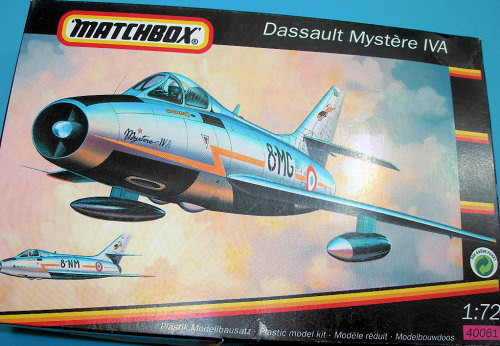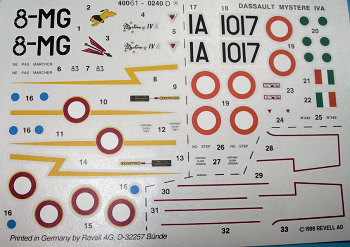
| KIT: | Revell/Matchbox 1/72 Mystere IVA |
| KIT #: | 40061/PK-47 |
| PRICE: | $ |
| DECALS: | Two options |
| REVIEWER: | Victor Scheuerman |
| NOTES: | 1998 Revell boxing of 1987 Matchbox kit |

| HISTORY |
The prototype of the Mystere IVA first flew in 1952 and with the Americans paying the bill as an off-shore procedure contract, an initial 225 aircraft were ordered. France added and paid for a further 100 aircraft and the majority served with the Armee de L’Air, some in a training role until 1982.
The Mystere did have some export success with 60 going to Israel and 110 new aircraft sold to India.
| THE KIT |
 Even though the box has Matchbox on
it, this is a Revell Germany boxing of this kit. The first indication that this
is not a ‘true’ Matchbox boxing (besides the box design and artwork) is the fact
that the kits 28 cleanly molded parts (some sing marks on fuselage cockpit
area)are molded in one colour; silver. A two-piece canopy finishes off the
plastic contents. This kit features a combination of raised and engraved panel
lines. Some of the engraved wing control outlines are overstated while the
airbrakes and small fuselage inlets are better done
Even though the box has Matchbox on
it, this is a Revell Germany boxing of this kit. The first indication that this
is not a ‘true’ Matchbox boxing (besides the box design and artwork) is the fact
that the kits 28 cleanly molded parts (some sing marks on fuselage cockpit
area)are molded in one colour; silver. A two-piece canopy finishes off the
plastic contents. This kit features a combination of raised and engraved panel
lines. Some of the engraved wing control outlines are overstated while the
airbrakes and small fuselage inlets are better done
As was common with this manufacturer, the cockpit detailing is basic. A Martin-Baker ejection seat shape is offered and this was used later(?) in service life. The initial seat(?) was a Hispano Mk 4 and this is offered in white metal by Aeroclub in set EJ024 and looks quite nice. As the cockpit opening is small and has an instrument coaming and was mostly painted black, by simply adding a seat harness and leaving the canopy closed should prove adequate.
A positive for the kit is that all gear bays are fully framed in and the nose bay is deeper then what is normally offered. While a one-piece nose gear is offered, the main gears are made up of three individual parts that includes the retraction arms. It is interesting that the large inner main doors are nice and thin with even the raised panel on the inside, but the complicatedly curved outer gear doors are thick like lumber and really should be carefully sanded thinner.
External stores are limited to a rocket pod (?) when it was normal to see these aircraft with wing tanks. Fortunately, the tanks and pylons from AIRFIX’s nice Super Mystere B2 can be used.
 Another indicator that this is a
Revell boxing are the instruction sheets. Nicely illustrated with detail colour
notes in each of the six construction steps. As there are no colour profiles on
the box, the decal placement and external colour guides for the two options are
fully covered in two excellent four views. The biggest improvement with the
Revell boxings are the decal sheets and this one is no exception.
Another indicator that this is a
Revell boxing are the instruction sheets. Nicely illustrated with detail colour
notes in each of the six construction steps. As there are no colour profiles on
the box, the decal placement and external colour guides for the two options are
fully covered in two excellent four views. The biggest improvement with the
Revell boxings are the decal sheets and this one is no exception.
A natural metal Mystere IVA from EC 1/8 ‘Saintonge’ is the first option and this features those great French heraldic unit insignia and also attractive yellow fuselage flash (supplied) and wing tips. This specific aircraft is shown in full colour on page 310 of The Encyclopedia of World Aircraft. An export Mystere is the second selection with an Indian Air Force example. This is also finished in natural metal but markings are limited to national and aircraft identifiers. All wing walkway guides are included on the sheet and both national roundels have separate centers; really a good looking and printed sheet.
| CONCLUSIONS |
This kit is what was best about the Matchbox series of aircraft kits; a unique subject that is adequate as is, or can be a great base for further detailing.
Your editor's pre-Revell Mystere
IV had an option for an Israeli aircraft as shown in the accompanying image,
built right from the box. 
| REFERENCES |
Replic No 105, Christian Kerrouche, 1/48 Hi-Tech kit (great one-stop reference)
The encyclopedia of World Aircraft, David Donald, PROSPERO BOOKS
The Complete Book of Fighters, William Green Gordon Swanborough, Salamander
If you would like your product reviewed fairly and quickly by a site that has nearly 400,000 visitors a month, please contact me or see other details in the Note to Contributors.